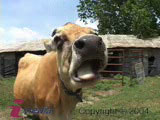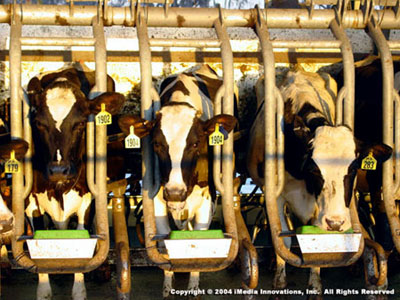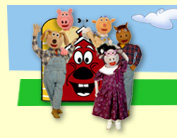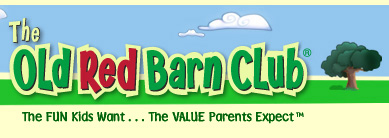|
Teaching
With
A Day on the Farm
In this program,
the characters spend a day on the farm discovering shapes, letters,
colors and sounds in addition to learning about life on a farm.
The program includes many musical numbers that are easy for children
to learn in addition to some standard children’s songs. A Day
on the Farm is composed of Pre-K and Life Experience Objectives
(see our Concepts page) as outlined below.
 Hay Making Module
Hay Making Module
In this learning module, Pete and Emmett work at a hay bale machine
and play a learning game where they guess (from each other’s
clues) objects made from hay. The actual clues are set to music and
sung by the children singers. Upon guessing each object, Pete and
Emmett sound out the first letter sound of the word, then name of
the object appears on the screen as the children voices (off screen)
provide the answer.
This module transitions into a Life Experience Module on haymaking.
Here, we see the major elements in growing, cutting, drying and bundling
hay. We also see and learn how hay is used as a major source of food
for animals as well as natural bedding material.
Pre-K Objectives
> Sounding out first letter sounds
> Associating alphabet letters with the sound
> Identifying object names from visual and auditory clues
> Basic spelling
Life Experience
Objectives
> Learning how hay is farmed and baled
> Seeing several types of haymaking machinery in action
> Going on a hayride
> Understanding hay as a source of food
Using Objectives
in the Classroom
Sounding out first letter sounds can be a fun and beneficial learning
experience in almost any environment (especially on long car rides.)
Here are some ways to play letter sound learning games with children.
Make sure to have the child guess the letter that goes with the sound
to complete the exercise.
- Give the child a word and have them sound out the first letter sound
- Have the child guess the first letter sound from a picture in a
book or magazine
- Guess the letter sound from real world objects outside a house or
car window
 Greenhouse Module
Greenhouse Module
In this learning module, Maria helps Reginald see the beauty in
objects by looking closely at the things around us. They play a
learning game where each identifies an animal from picture clues
which contain detailed close-ups of the animal as well as a rhyme
that provides auditory clues. Children voices (off screen) provide
the answer as a full-screen image of the animal appears.
Maria also speaks several words and phrases in Spanish, while immediately
providing the English translation. This English-Spanish translation
is carried off in a subtle manner rather than a formal instruction.
Pre-K Objectives
> Identifying animals from detailed picture and auditory
clues
> Basic Spanish-English translation
Using Objectives
in the Classroom
Pictures of animals may be cut up and put into a pile. Children
pull a piece out and try to guess the animal. This exercise works
with just about any animal as well as any object. The ease of the
learning game will be determined by the size and details present
in the cut piece.
 Equestrian Module
Equestrian Module
In this module, children see and experience other children as they
learn the basics of riding, show jumping and caring for their horse.
Life experience
Objectives
> Seeing children ride horses
> Experiencing show jumping
> Learning about caring for horses
 Farmstand Module
Farmstand Module
In this module, Emmett shops at Pete’s farmstand for the upcoming
picnic lunch. Clues to items needed are sung to music by children
singers. Each item is associated with the item name, its spelling,
color and quantity. In addition, Pete plays a short first-letter
sound game with himself in the scene opening, reinforcing how easy
and fun it is to guess the first letter sounds from things we see.
This scene is very visual graphically and shows object relationships
during the clue giving portion of the learning game.
Pre-K Objectives
> Colors
> Quantities and numerals
> Spelling
> First letter sounds
Life experience
Objectives
> Seeing fruits and vegetables in a farmstand setting
Using Objectives
in the Classroom
Examples of various foods may be presented to children. They then
guess the name and color. Add several of each kind and guess the
quantities. Add and take away items to cover basic math skills.
 Lunchtime Song
Lunchtime Song
This fun musical number shows animals doing what they do best -
eating! It is a visual review set to music of various animals in
their natural environment.
Life experience
Objectives
> Seeing animals in their natural environment
 Shapes Module
Shapes Module
In this module, Wilma searches for the oval shape among various
shapes visual on the screen. Several animated farm scenes are presented
where Reginald prompts Wilma and the viewer to identify shapes within
the scene. Answers are given by the children voices (off screen)
and highlighted on the screen.
The storyline for this scene is Wilma is looking for precious gems
on a farm and was told to look for ovals to find the gems. The gems
turn out to be baby chicks and the Shapes Module resolves itself
into scenes of chickens and baby chicks.
Pre-K Objectives
> Identifying shapes in a drawing of a farm scene
> Quantities and numbers
Life experience
Objectives
> Seeing chickens, roosters and baby chicks
> Look closely for the baby bunnies!
Using Objectives
in the Classroom
Shapes may be identified from pictures, items in view, items outside
a window and just about anywhere children can see. Turning this
game into an “I SPY” game is a great way to break up a
long trip or spend a period of time.
 Old MacDonald Module
Old MacDonald Module
In this module, Pete and Maria try to guess the name of animals
from the sounds they make. The learning game is set to the song
“Old MacDonald” and contains sounds, visual clues and
children voices (off screen) to prompt the viewer.
Pre-K Objectives
> Identifying animals by their sounds
> Identifying animals by their silhouettes
> Spelling
Life experience
Objectives
> Seeing cows and ducks
Using Objectives
in the Classroom
Sounding out animal sounds for children to guess the animal is one
way to teach animal sounds. You may also show pictures and have
the children guess both the animal and the sound it makes.
 Dairy Farm Module
Dairy Farm Module
This life experience module transitions from the Old MacDonald module
to focus on life on a dairy farm. Viewers experience how cows are
milked, fed and cared for on a large-scale dairy farm.
Life experience
Objectives
> Seeing cows in a dairy farm setting
> Understanding the basic flow of milk from the cow to
the milk glass
 Honey Farm Module
Honey Farm Module
In this closing module, viewers are taken into the heart of a honey
farm where honey is cultivated and queen bees are grown and bread
for sale to other honey producers. The visuals in this module conveys
the feeling of being in an environment of millions of buzzing bees
within a small area. The results are not only fascinating, but tasty!
Life experience
Objectives
Seeing honey bees making honey
Seeing other children display tremendous responsibilities
|



 Hay Making Module
Hay Making Module 




 Greenhouse Module
Greenhouse Module Equestrian Module
Equestrian Module Farmstand Module
Farmstand Module Lunchtime Song
Lunchtime Song Shapes Module
Shapes Module Old MacDonald Module
Old MacDonald Module Dairy Farm Module
Dairy Farm Module Honey Farm Module
Honey Farm Module